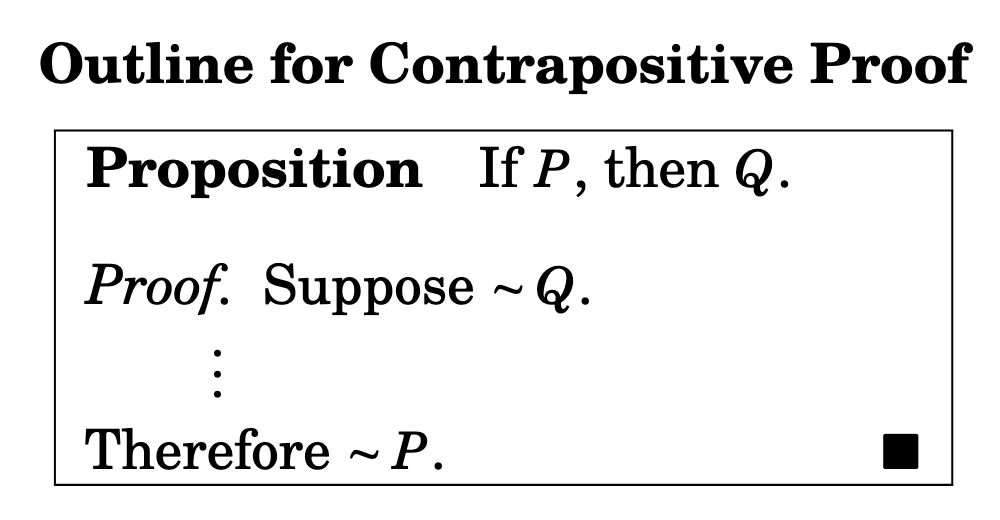Lecture 8 - Notes
Contrapositive Proof
- Know how to use contrapositive proof to show \(P \Rightarrow Q\) by showing that \(\neg Q \Rightarrow \neg P\).
- Practice writing proofs.
Modular Equivalence
- Know and be able to apply the definition of congruence
modulo \(\mathbf{n}\)
Announcements
Modular Congruence
Definition: Given integers \(a\) and \(b\) and \(n \in
\mathbb{Z}\), we say that \(a\)
and \(b\) are congruent
modulo \(\mathbf{n}\) if \(n \mid (a - b)\). We write this as \(a \equiv b \pmod{n}\). If \(a\) and \(b\) are not congruent modulo \(n\), then we write \(a \not\equiv b \pmod{n}\).
Do Exercises Part A
The Contrapositive
We have seen: \[
P \Rightarrow Q \equiv \neg Q \Rightarrow \neg P
\]
Intuition?
A possible way to build intuition for this is using a statement
like:
“All humans are mammals”
which we can rephrase as
“If you are human, then you are a mammal”
If that’s the case, then the following statement rings true to our
intuition:
“If you are not a mammal, then you are not human.”
Contrapositive Proof
The fact that \(P \Rightarrow Q\)
and its contrapositive are logically equivalent means that
showing \(\neg P \Rightarrow \neg Q\)
is just as good as showing \(P \Rightarrow
Q\). So we can prove \(P \Rightarrow
Q\) as follows:

Example
Proposition: Suppose \(x,
y \in \mathbb{Z}\). If \(5 \nmid
xy\), then \(5 \nmid x\) and
\(5 \nmid y\).
See whiteboard notes for proof.
Book of Proof’s Style Guide
- Begin each sentence with a word, not a mathematical symbol.
- End each sentence with a period, even when the sentence ends with a
mathematical symbol or expression.
- Separate mathematical symbols and expressions with words.
- Avoid misuse of symbols.
- Avoid using unnecessary symbols.
- Use the first person plural.
- Use the active voice.
- Explain each new symbol.
- Watch out for “it”, unless it’s completely unambiguous what “it”
refers to.
- Since, because, as, for, so are used to mean that P is true (or
assumed to be true) and as a consequence Q is true also.
- Thus, hence, therefore, consequently precede a statement that
follows logically from previous sentences or clauses.
- Clarity is the gold standard of mathematical writing.
Definitions
Definition: An integer \(n\) is even if \(n = 2a\) for some integer \(a \in \mathbb{Z}\).
Definition: An integer \(n\) is odd if \(n
= 2a + 1\) for some integer \(a \in
\mathbb{Z}\).
Definition: Suppose \(a\) and \(b\) are integers. We say that \(a\) divides \(b\), written \(a
| b\), if \(b = ac\) for some
\(c \in \mathbb{Z}\). In this case we
also say that \(a\) is a
divisor of \(b\), and
that \(b\) is a
multiple of \(a\).
Definition: Two integers have the same
parity if they are both even or they are both odd. Otherwise
they have opposite parity.
Definition: Given integers \(a\) and \(b\) and \(n \in
\mathbb{Z}\), we say that \(a\)
and \(b\) are congruent
modulo \(\mathbf{n}\) if \(n \mid (a - b)\). We write this as \(a \equiv b \pmod{n}\). If \(a\) and \(b\) are not congruent modulo \(n\), then we write \(a \not\equiv b \pmod{n}\).

